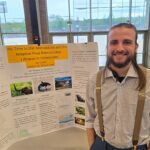
Prognostic Factors for Meningioma Growth: A Meta-Analysis

Name: David Lee Dotson
Major: Neuroscience (Biology)
Minor: Music
Advisor: Nicholas Brandley; Seth Kelly (second reader)
Many studies have reported connections between certain factors and meningioma growth rates, but each provides a different account of what factors are significant predictors and to what degree. Therefore, these prognostic factors must be verified across multiple studies to determine their usefulness to the medical research community and medical practice. I conducted a systematic review of the literature using Google Scholar and citation mining and meta-analyzed 18 studies to investigate the correlation between meningioma growth rate and multiple prognostic factors (calcification, peritumoral edema, T2-weighted MRI hyperintensity, initial tumor size, skull base tumor location, patient sex assigned at birth, and patient age). The growth rate was negatively correlated with tumor calcification but positively correlated with peritumoral edema, MRI T2 signal, and initial tumor size. No association was found between tumor growth and other features such as skull base location, patient sex assigned at birth, and patient age. For WHO grades, there were not enough studies included to perform a meta-analysis. Meningiomas with peritumoral edema, hyperintense T2-weighted MRI signal, and large initial size indicate a rapid-growth meningioma, which supports surgery as the best treatment strategy. Conversely, meningiomas with calcification are best addressed with the “wait and see” approach.
Posted in Comments Enabled, Independent Study, Symposium 2023 on April 13, 2023.
2 responses to “Prognostic Factors for Meningioma Growth: A Meta-Analysis”
Related Posts
Related Areas of Study
Neuroscience
Psychology, chemistry, philosophy, computer science, and other disciplines combine in the study of the nervous system
MajorMusic
Earn a bachelor of arts in music or a bachelor of music in either music performance or music composition
Major Minor


Congratulations, David!!
David – A meta-analysis is a major undertaking! Great job conducting this analysis and developing this presentation. Enjoy symposium day!